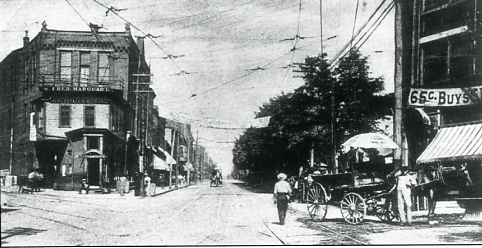
Click Here to Return to Milestones

This popular sale was advertised on the banner
across the Two John's-Butler and Jackson-clothing store on Brighton
Avenue in Rochester in 1907. (building on the right in above photograph)
To patrons this sale meant enormous discounts. If a Suit was priced
at $10, a customer could buy it for $6.50. To the management the
sale cleared the shelves and the stockroom of excess winter coats
and clothes.
Two John's was established by John A. Butler and John Jackson
in 1882. It grew into the largest clothier in the area during
the early 1900s. The business had a reputation for quality merchandise
at an affordable price. Butler and Jackson were known for their
fair treatment of patrons.
In front of Two John's a horse takes a break and enjoys a drink
from the watering trough. Horse-drawn carts were a familiar sight
on Brighton Avenue as were trolleys.
The umbrella on the cart to the right advertises the Ewing Brothers
stores in New Brighton and Rochester.
The clothing store was established in Rochester in October 1885,
by John I. Kirk and James H. Ewing. When Kirk retired on Dec.
1. 1894, Ewing bought the business located in the Leaf Building
on Brighton Avenue. By 1907 Frank A. Ewing and Edgar A. Ewing
had joined their brother in the clothing venture.
Fred Marquart came to Rochester in 1878 and started a restaurant
in the Power Building on Railroad Street. In 1885 he bought a
building from the Pat O'Kean heirs located on Brighton Avenue
and Pleasant Street.
In 1896, Marquart had the building torn down, and the above three-story
business and residential block was erected and known as the Marquart
Building.
The first floor of the building housed M. Finn's dry goods store,
W. F. Workman's wholesale and retail tobacco store, Marquart's
real estate office, and the Rochester Postcard Co.
On the second floor patrons entered the display room of Finn.
Down the hall were the offices of Frank E. Mathew, architect and
V. Orrin Strowe, contractor. Marquart used a small room for his
sleeping quarters.
The third floor was occupied by Workman's cigar factory and a
large hall for lodge purposes.
On Feb. 10, 1908, the Marquart Building and its entire contents
were destroyed by fire.